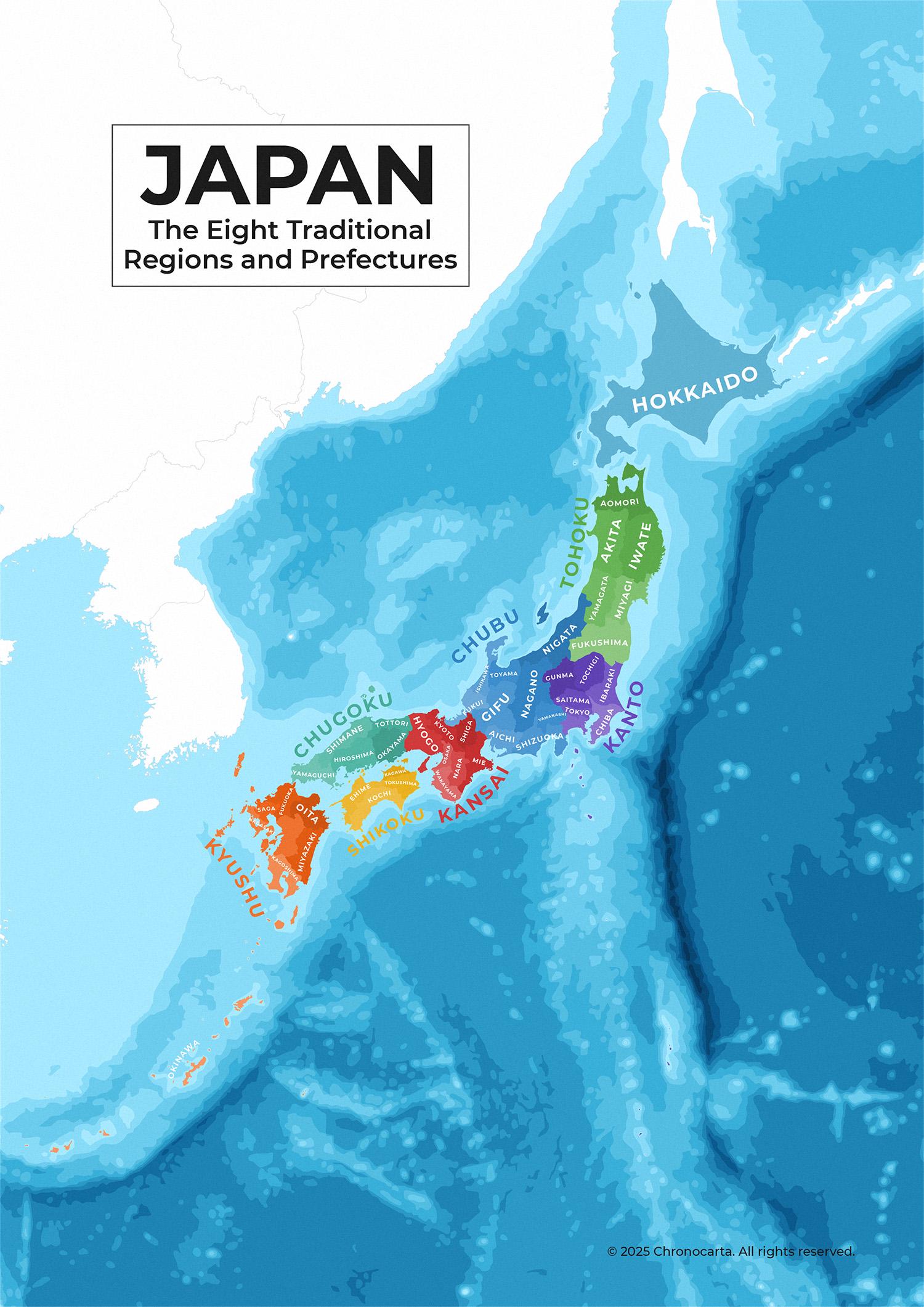Japan’s Traditional Regions and Prefectures Map


Marcus Rodriguez
Historical Geography Expert
Marcus Rodriguez specializes in historical cartography and geographic data analysis. With a background in both history and geography, he brings unique...
Geographic Analysis
What This Map Shows
This detailed administrative map of Japan illustrates the country's eight traditional regions and their corresponding prefectures, color-coded for easy reference. Each region is distinctly marked, allowing viewers to quickly identify the geographical boundaries and administrative divisions of Japan. The map also includes neighboring countries, providing a broader context of Japan's location within East Asia. Understanding these regions is essential to grasping Japan's cultural and historical diversity.
Deep Dive into Japan's Traditional Regions
Japan is often described as a land of contrasts, where ancient traditions coexist with cutting-edge technology. The eight traditional regions—Hokkaido, Tohoku, Kanto, Chubu, Kansai, Chugoku, Shikoku, and Kyushu—each possess unique characteristics that reflect their histories, climates, and cultural practices.
Hokkaido, the northernmost region, is known for its stunning natural landscapes, including vast national parks and ski resorts. Interestingly, Hokkaido was once home to the indigenous Ainu people, whose rich cultural heritage is still celebrated today.
Tohoku, located in the northeast, is renowned for its rural charm and traditional festivals. It experiences harsh winters, which has shaped its agricultural practices. Have you ever considered how climate influences culture? In Tohoku, the cold climate has led to unique culinary traditions, such as hearty rice dishes and warming sake.
Moving south, we encounter the Kanto region, which includes Tokyo, Japan's bustling capital. Kanto is the economic powerhouse of the nation, housing major corporations and cultural institutions. The stark contrast between the modern urban landscape of Tokyo and the serene temples of nearby Nikko illustrates the blend of history and modernity that defines Japan.
Chubu is centrally located and is known for its diverse topography, ranging from the Japanese Alps to coastal plains. This region is pivotal for transportation and trade, making it a hub for both tourists and businesses. Interestingly, Chubu is also home to Mount Fuji, Japan's iconic peak, which attracts millions of visitors every year.
Kansai, often regarded as the cultural heart of Japan, encompasses cities like Kyoto and Osaka. Kyoto, with its historical temples and shrines, offers a glimpse into Japan's rich past, while Osaka is famous for its vibrant street food scene. This region exemplifies how regional culinary differences can reflect historical trade routes.
Chugoku, located in the west, is known for its rugged landscapes and historical sites, including Hiroshima and Okayama. The Peace Memorial Park in Hiroshima serves as a poignant reminder of the city's tragic past and its ongoing message of peace.
Shikoku, the smallest of the four main islands, is famous for its 88-temple pilgrimage route. This spiritual journey attracts both local and international travelers, highlighting how geography can influence religious practices.
Lastly, Kyushu, the southernmost region, is known for its volcanic activity and hot springs. The region's unique geology shapes its agricultural output, particularly in rice and citrus production. Interestingly, Kyushu's proximity to other Asian countries has fostered a rich exchange of culture and ideas throughout history.
Regional Analysis
Each of Japan's traditional regions boasts distinct characteristics shaped by geography, climate, and culture. For example, while Hokkaido's economy is driven by agriculture and tourism, the Kanto region thrives on technology and finance. The stark differences in climate also affect agricultural outputs—Tohoku’s cold climate promotes rice farming, while Kyushu’s warmer weather supports a variety of citrus fruits.
In terms of demographics, Kanto stands out with its high population density, primarily due to Tokyo's urban sprawl. In contrast, Tohoku and Hokkaido have more dispersed populations, reflecting their rural landscapes. This demographic distribution raises questions about urbanization, sustainability, and the future of Japan's rural communities as younger generations migrate to cities for opportunities.
Significance and Impact
Understanding Japan's traditional regions and prefectures is not just an academic exercise; it has real-world implications. These regions affect everything from economic development to cultural preservation. As Japan faces challenges such as an aging population and declining birth rates, regional differences will play a crucial role in shaping policies for the future.
Moreover, the significance of these regions extends to tourism, where travelers seek authentic experiences unique to each area. For instance, the cultural festivals in Tohoku attract visitors eager to witness traditional practices, while the culinary delights of Kansai draw food enthusiasts from around the globe.
As Japan continues to balance modernization with tradition, understanding these regional distinctions will be vital for policymakers, businesses, and travelers alike. The future of Japan’s identity and heritage lies in its ability to embrace both its rich history and its dynamic present, making the study of its traditional regions all the more important.
Visualization Details
- Published
- August 12, 2025
- Views
- 136
Comments
Loading comments...